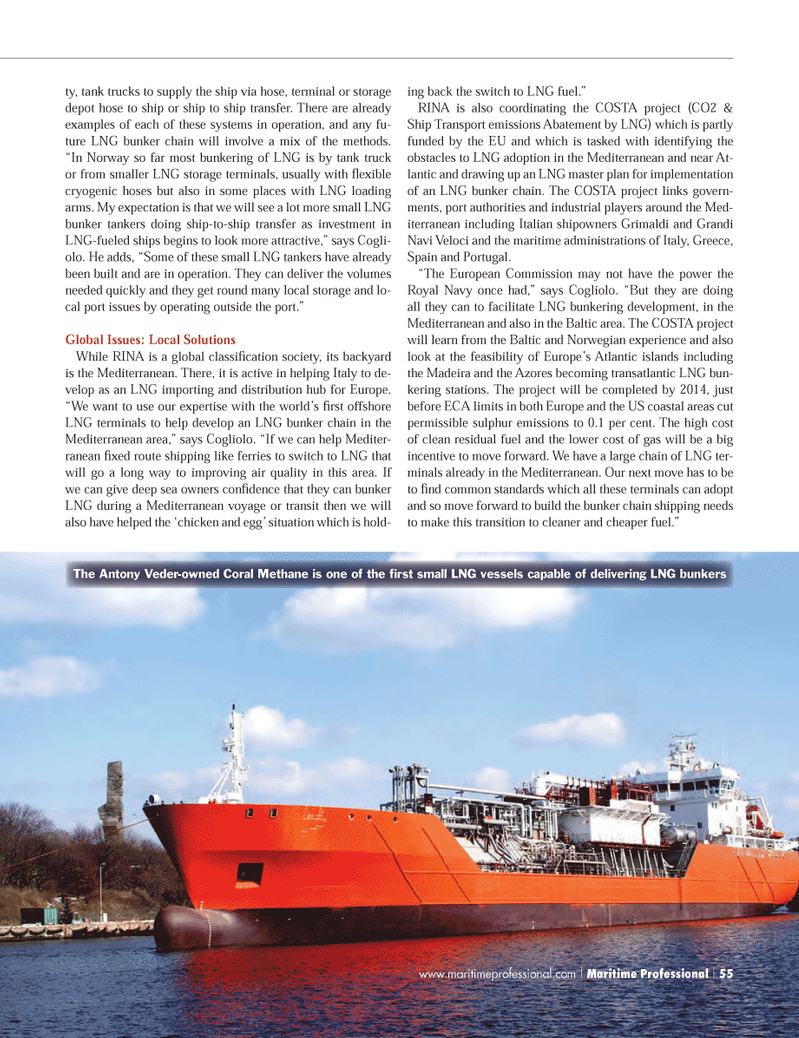
Page 55: of Maritime Logistics Professional Magazine (Q3 2012)
Classification Societies, Quality & Design
Read this page in Pdf, Flash or Html5 edition of Q3 2012 Maritime Logistics Professional Magazine
ty, tank trucks to supply the ship via hose, terminal or storage depot hose to ship or ship to ship transfer. There are already examples of each of these systems in operation, and any fu- ture LNG bunker chain will involve a mix of the methods. ?In Norway so far most bunkering of LNG is by tank truck or from smaller LNG storage terminals, usually with exible cryogenic hoses but also in some places with LNG loading arms. My expectation is that we will see a lot more small LNG bunker tankers doing ship-to-ship transfer as investment in LNG-fueled ships begins to look more attractive,? says Cogli- olo. He adds, ?Some of these small LNG tankers have already been built and are in operation. They can deliver the volumes needed quickly and they get round many local storage and lo- cal port issues by operating outside the port.? Global Issues: Local SolutionsWhile RINA is a global classi cation society, its backyard is the Mediterranean. There, it is active in helping Italy to de- velop as an LNG importing and distribution hub for Europe. ?We want to use our expertise with the world?s rst offshore LNG terminals to help develop an LNG bunker chain in the Mediterranean area,? says Cogliolo. ?If we can help Mediter- ranean xed route shipping like ferries to switch to LNG that will go a long way to improving air quality in this area. If we can give deep sea owners con dence that they can bunker LNG during a Mediterranean voyage or transit then we will also have helped the ?chicken and egg? situation which is hold- ing back the switch to LNG fuel.? RINA is also coordinating the COSTA project (CO2 & Ship Transport emissions Abatement by LNG) which is partly funded by the EU and which is tasked with identifying the obstacles to LNG adoption in the Mediterranean and near At- lantic and drawing up an LNG master plan for implementation of an LNG bunker chain. The COSTA project links govern- ments, port authorities and industrial players around the Med-iterranean including Italian shipowners Grimaldi and Grandi Navi Veloci and the maritime administrations of Italy, Greece, Spain and Portugal.?The European Commission may not have the power the Royal Navy once had,? says Cogliolo. ?But they are doing all they can to facilitate LNG bunkering development, in the Mediterranean and also in the Baltic area. The COSTA project will learn from the Baltic and Norwegian experience and also look at the feasibility of Europe?s Atlantic islands including the Madeira and the Azores becoming transatlantic LNG bun- kering stations. The project will be completed by 2014, just before ECA limits in both Europe and the US coastal areas cut permissible sulphur emissions to 0.1 per cent. The high cost of clean residual fuel and the lower cost of gas will be a big incentive to move forward. We have a large chain of LNG ter- minals already in the Mediterranean. Our next move has to be to nd common standards which all these terminals can adopt and so move forward to build the bunker chain shipping needs to make this transition to cleaner and cheaper fuel.? The Antony Veder-owned Coral Methane is one of the Þ rst small LNG vessels capable of delivering LNG bunkers www.maritimeprofessional.com | Maritime Professional | 55

 54
54

 56
56
